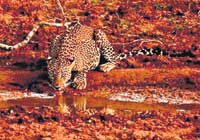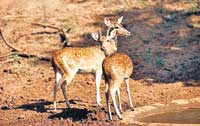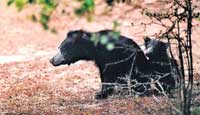
Yala animals get drought break“When first I came to my new jungle home at the end of July, there had been no rain in this whole Ruhunu area. The good earth was parched and cracked and hard as concrete; trees, bushes, shrubs and grass all burnt a pale sienna brown. I was able to see far into scrub jungle as there was hardly any foliage, and dead leaves crunched under my foot as I walked. Across a wide salt pan or lewaya, I could have driven a high powered car with no fear of sinking into the hard crust of salt.” This is how Douglas Raffel unveiled the “The Great Thirst” experienced during the drought in the first chapter of his book, “In Ruhunu Jungles”.
Yala, the country’s most popular National Park is traditionally closed to visitors from September 1 to mid-October during the height of the drought. This is to avoid any disturbance to already wearied animals by hundreds of visitors and moving vehicles. This year, however the closure has been reduced by two weeks and in response to requests from the travel industry, Yala Park will open on October 16. This decision was taken by the Department of Wildlife Conservation after studying the ground conditions, considering the good rainfall enjoyed during the period. As the most popular park in Sri Lanka, Yala has become a hot-spot of Sri Lanka’s tourism. “This year the park received pre-monsoon rain and the drought is not severe. In addition the measures we have taken last year to sustain water such as deepening water holes have also assisted to keep the water. Considering the request from the tourism sector and carefully assessing the ground situation, the Department of Wildlife Conservation decided to shift the closing date by 14 days,” park warden W.S.Weragama said. Located in the arid zone, the Yala Park gets rain mainly from the North-east monsoon, from November to January. The inter-monsoon rains in March/April and September also provide water, but are unpredictable. The dry season usually starts in June and continues until September/mid October.
At this time temperatures can rise to a high of 37oC, although the mean annual temperature is 27 oC. Average rainfall is 1281mm, but it is lower in Block III, IV, V and the Strict Nature Reserve which receives from 550-775 mm. The drought is most severe during the pre-monsoonal months of September/October. The need of a closure was first suggested in 1950 by the Game and Fauna Protection Society (presently Wildlife and Nature Protection Society – WNPS). It was initially for a period of two months and later reduced to 45 days. Drought is a blessing “Drought is a blessing of nature,” states Childers Jayawardene, who was Yala Park warden in the late ’70s. “Drought eliminates the sick and weak animals. Next year after the drought, what we have is a healthier animal population. Drought is nature’s way of maintaining life.” Hence, the mechanisms to minimize the damages of the drought should be carefully considered, says Mr. Jayawardene. As vividly described by Raffel, the park loses its greenery completely during the drought. The water-holes start to disappear and animals congregate around the remaining water sources. Lack of food sources and thirst usually make the animals restless and they sometimes fight for the scarce resources. Water holes – the lifeline “Everywhere were the signs of a great thirst and of a great hunger too, for with no green leaves and grass, their hunger was as great as their thirst. Visiting two well known water-holes, I found where there had once been water, the sun-baked footprints of wild animals and birds in the hard ground. In a river twenty-two miles away was now the closest water, and there too only at certain pools. Crocodiles had left the river and roamed far. Lullas (a fish) had dug themselves into the earth till the rains came. Everywhere was the desolation of the drought,” Raffel wrote, describing the drought in, “In Ruhunu Jungles”. Menik Ganga is indeed the lifeline during a bad drought. There are also several natural and man-made tanks such Gonagala, Mandagala, Uraniya, Mahaseelawa, Heenwewa, Korawakka that are the major water sources, until they completely dry up. Several natural rock pools known as kema also hold water even during the height of the drought. Welmakkema, Jamburagala, Padikema, Kimbulagala, Walaskema are some of them.
These rock water pools are sometimes filled by park management during severe droughts by placing large concrete basins at the bottoms and creating artificial ponds. During the critical time, when the water gets completely exhausted, water bowsers are sent to fill them up once in two days and animals are now used to waiting eagerly for the browser to arrive. This initiative was also supported by other organizations and those in the area. Poaching during the drought Drought is the easiest period to hunt game. Hunters only need to wait at a hideout till the thirsty animals emerge. Several years ago, during one of the worst droughts, it was revealed that poachers would dig holes and place bags of water mixed with poison which was drunk by animals like the Spotted Deer, Sambhur and Wild Boar who then suffered an agonizing death. The park management has now strengthened anti-poaching activities during the drought. Mobile units are sent to nab illegal entrants and small camps are set up in strategic places to deter poachers. The closure of the park frees up additional manpower for these efforts. Animals’ response to the drought Elephants who remain on high ground around Jamburagala during the wet season, come down to the plains during the dry season. As the drought sets in, elephants again start moving away from the coastal belt – some toward the perennial waters of Menik ganga and Blocks II and III, while other herds move to Meynert wewa, Heenwewa, Katagamuwa and even to settlements outside the park. With the rains in November-December, they return to the coastal belt. But deepening of tanks and managing of water sources during the drought have altered some of these migratory patterns, with animals staying inside the park itself. Elephants are also good at finding water. They can sense the water beneath a dried-up riverbed and have the strength to dig the sand in search of water. Other animals follow them to get this rare fresh water source. Some people believe Yala should not be closed as most of the other parks are not, even during drought periods. But Yala has a unique climatic and hydrologic condition and the welfare of wildlife during the drought should be the key in taking the decision. On the other hand, simply closing it on a given date also does no good. The decision to open/close the park should hinge on this delicate balance of the welfare of its animals and of the dependents. Soon, the drought will be over and the park will be open to visitors. This is how Raffel saw the rebirth of the “Ruhunu Jungles” after the drought. “On one night I woke to the sound of rain pattering on the roof noisily. The rain was pouring down on us at last! ……As though by magic, a fresh green mantle covers the khaki and brown jungle of yesterday. Transparent scrub has become thick jungle through which you cannot see. Already flowers adorn each bush. Birds keep chasing each other about and I have seen the foundation stones of several nests. It is almost unbelievable that all this could happen in four days.” Yala re-opens on October 16. |
|| Front
Page | News | Editorial | Columns | Sports | Plus | Financial
Times | International | Mirror | TV
Times | Funday
Times || |
| |
Reproduction of articles permitted when used without any alterations to contents and the source. |
© Copyright
2007 Wijeya
Newspapers Ltd.Colombo. Sri Lanka. All Rights Reserved. |


